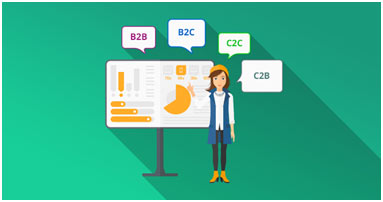- 1) Models of Ecommerce, Forms, and Growth in Ecommerce
- 2) Models of Ecommerce
- 3) Business-to-business (B2B) e-commerce
- 4) Business-to-consumer (B2C)
- 5) Consumer-to-consumer (C2C)
- 6) Consumer-to-business (C2B)
- 7) Business-to-administration (B2A)
- 8) Consumer-to-administration (C2A)
- 9) Mobile e-commerce (M-commerce)
- 10) Forms of Ecommerce
- 11) Growth of Ecommerce
Models of Ecommerce, Forms, and Growth in Ecommerce
Ecommerce (or electronic commerce) is the trading of products (or services) on the internet. It incorporates a wide range of data, systems, and tools for online purchasers and sellers, consisting of mobile shopping and online payment encryption.
Most businesses with an e-commerce presence use an e-commerce store and/or a platform to carry out online marketing and sales activities and to manage logistics and fulfillment.
Models of Ecommerce
There are 6 main models of e-commerce that can be categorized into:
- B2C
- B2B
- C2C
- C2B
- B2A
- C2A
Business-to-business (B2B) e-commerce
This describes the electronic exchange of products, services, or details in between services instead of between businesses and customers. Examples consist of online directories and product and supply exchange sites that enable businesses to search for products, services, and information and to initiate deals through e-procurement interfaces.
Business-to-consumer (B2C)
This is the retail part of e-commerce on the internet. It is when businesses offer products, services or information directly to consumers. The term was popular throughout the dot-com boom of the late 1990s, when online retailers and sellers of goods were a novelty.
Today, there are numerous virtual shops and shopping centers on the internet selling all kinds of durable goods. The most acknowledged example of these sites is Amazon, Alibaba which dominates the B2C market.
Consumer-to-consumer (C2C)
C2C is a kind of e-commerce in which customers trade products, services and information with each other online. These deals are usually conducted through a third party that provides an online platform on which the deals are performed.
Online auctions and categorized advertisements are two examples of C2C platforms, with eBay and Craigslist being two of the most popular of these platforms. Because eBay is an organization, this kind of e-commerce might also be called C2B2C– consumer-to-business-to-consumer.
Consumer-to-business (C2B)
It is a kind of e-commerce in which consumers make their services and products offered online for business to bid on and purchase. This is the opposite of the standard commerce model of B2C. A popular example of a C2B platform is a market that offers royalty-free photos, images, media and style components, such as iStock.
Business-to-administration (B2A)
It refers to transactions conducted online between companies and public administration or government bodies. Many branches of government are dependent on e-services or products in one way or another, particularly when it pertains to legal documents, signs up, social security, fiscals and employment.
Organizations can supply these electronically. B2A services have actually grown substantially in recent years as financial investments have been made in e-government capabilities.
Consumer-to-administration (C2A)
It describes deals performed online in between private customers and public administration or government bodies. The federal government seldom purchases service or products from residents;however, individuals regularly utilize electronic methods in the following locations:
- Sharing info, distance learning/online lectures, etc.
- Social security. Dispersing info, making payments, and etc.
- filing income tax return, paying, etc.
- Making consultations, supplying information about diseases, making health services payments, etc.
Mobile e-commerce (M-commerce)
M-commerce is a type of e-commerce increasing that features online sales deals used mobile devices, such as smart devices and tablets. M-commerce includes mobile shopping, mobile banking and mobile payments. Mobile chatbots also offer e-commerce opportunities to organizations, enabling customers to total transactions with business by means of voice or text discussions.
Forms of Ecommerce
Ecommerce can take on a variety of forms including various transactional relationships between businesses and customers, in addition to different objects being exchanged as part of these transactions.
1.Retail
The sale of an item by an organization straight to a customer with no intermediary.
2.Wholesale
The sale of items wholesale, typically to a merchant that then sells them straight to consumers.
3.Dropshipping
The sale of a product, which is produced and shipped to the customer by a third party.
4.Crowdfunding
The collection of cash from consumers in advance of a product being readily available in order to raise the start-up capital necessary to bring it to market.
5.Subscription
The automated recurring purchase of a product or service on a regular basis until the customer chooses to cancel.
6.Physical products
Any concrete excellent that requires stock to be replenished and orders to be physically shipped to consumers as sales are made.
7.Digital products
Downloadable digital goods, design templates, and courses, or media that should be bought for usage or accredited for usage.
8.Services
An ability or set of skills supplied in exchange for settlement. The service’s time can be acquired for a charge.
Growth of Ecommerce
Ecommerce has come a long way because of the CompuServe launch in 1969. Changes in technology have definitely driven e-commerce growth, in addition to global scenarios. Today, e-commerce needs to satisfy customers’ expectations for security and convenience. COVID-19 pandemic around the globe pushed consumers online to unprecedented levels.
By May of 2020, e-commerce deals reached $82.5 billion– a 77% boost from 2019. It would have taken four to six years to reach that number looking at traditional year-over-year boosts. Consumers have actually moved online to make purchases usually made in physical shops, such as food and home products, apparel, and home entertainment. Many consumers say they’ll continue to utilize online shops up until a COVID-19 vaccine is available.

